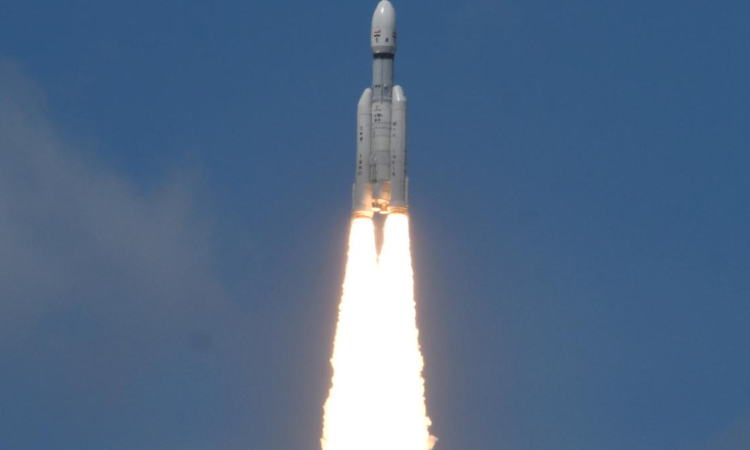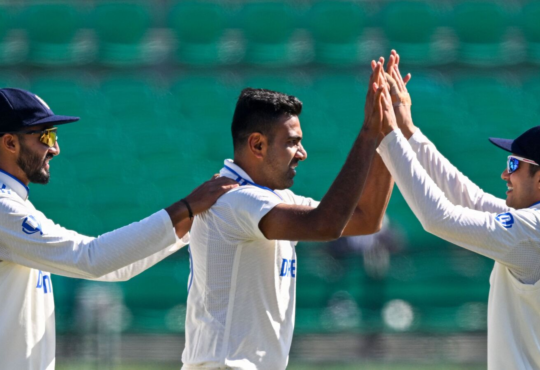Chandrayaan-3 launch news | ISRO plans soft landing on August 23, payloads RAMBHA, ILSA to help understand … – The Hindu

To enjoy additional benefits
CONNECT WITH US
July 14, 2023 10:22 am | Updated 09:58 pm IST
COMMents
SHARE
READ LATER
The Indian Space Research Organisation launch the LVM3-M4/Chandrayaan-3 Moon Mission, lift off from the second launch pad at Satish Dhawan Space Centre-SHAR, Sriharikota in Andhra Pradesh on July 14, 2023. Photo: B. Jothi Ramalingam / The Hindu
India’s third moon mission, Chandrayaan-3, was successfully launched onboard a Launch Vehicle Mark-3 (LVM-3) rocket from the second launch pad at the Satish Dhawan Space Centre in Sriharikota at 2.35 pm on July 14.
This is India’s second attempt at soft-landing robotic instruments on the lunar surface after the previous attempt, Chandrayaan-2, failed in 2019.
Thus far, only three countries, the U.S., Russia and China, have successfully soft-landed on the moon.
Speaking to reporters after the successful launch, ISRO Chairman S. Somanath said the next 42 days are crucial. “As per the nominal programme, we will have five earth-bound manoeuvres [that] will end on July 31. After that we have the trans-lunar insertion, [which] will take place on August 1. After that, it will be captured [by the] moon.This will be followed by the separation of the propulsion module and the lander module on August 17. “The landing is currently planned on August 23 at 5.47 pm IST, if everything goes as per plan,” he added.
New chapter: Modi
Hailing the launch, Prime Minister Narendra Modi tweeted: “Chandrayaan-3 scripts a new chapter in India’s space odyssey. It soars high, elevating the dreams and ambitions of every Indian… This momentous achievement is a testament to our scientists’ relentless dedication. I salute their spirit and ingenuity!”
Minister of State Jitendra Singh, who was present at the launch, said, “It is indeed a moment of glory for India. Thank you team ISRO for making India proud… Today is also a day of vindication: vindication of the dream Vikram Sarabhai [had] six decades ago.”
Also read | ISRO’s Chandrayaan 3 mission | When did it start and when will it end
Around 16 minutes after the LVM-3 lifted off, the spacecraft separated from the rocket. It was an integrated module comprising the propulsion module, the lander module, and the rover. It entered into an elliptic parking orbit (EPO). This orbit’s closest approach to earth was around 170 km and farthest, at 36,500 km.
The Chandrayaan-3 consists of an indigenous propulsion module (PM), lander module (LM). The mission’s objective is to develop and demonstrating new technologies required for inter-planetary missions.
The propulsion module will carry the lander (containing the rover) from the EPO around earth to a circular orbit around the moon, at an altitude of 100 km. This module also carries instrument called ‘Spectro-polarimetry of Habitable Planetary Earth’ (SHAPE), to study spectral emissions coming from earth.
According to ISRO, the lander can soft-land at a specified lunar site and deploy the rover. The rover will perform in-situ chemical studies of the lunar surface as it moves around. The lander also has scientific instruments to study the lunar surface and subsurface.
The propulsion module will execute a series of manoeuvres over the next month to sling itself towards the moon and be caught there by the moon’s gravity. Once it has been captured into a lunar orbit, the lander will detach itself and attempt to soft-land on the moon’s surface.
The Chandrayaan-3 mission’s objective is to develop and demonstrate new technologies required for inter-planetary missions.
Here are the latest updates:
The successful launch of India’s ambitious moon mission Chandrayaan-3 on Friday was one more achievement for the country under the leadership of Prime Minister Narendra Modi, said Gujarat Chief Minister Bhupendra Patel.
A statement from the Gujarat CMO said Mr. Patel congratulated all those associated with the mission and expressed happiness for the successful launch of Chandrayaan-3.
Wishing the successful completion of every next phase in the mission, Mr. Patel said, “Under the leadership of PM Narendra Modi, India is achieving world-class achievements at regular intervals and today’s launch of Chandrayaan-3 has become another milestone.”
Greetings and best wishes poured in as India launched Chandrayaan 3 on GSLV Mark 3 (LVM 3) successfully from Andhra Pradesh’s Sriharikota on Friday.
NASA administrator Bill Nelson took it to Twitter and wrote, “Congratulations to @isro on the Chandrayaan-3 launch, wishing you safe travels to the Moon. We look forward to the scientific results to come from the mission, including NASA’s laser retroreflector array. India is demonstrating leadership on #ArtemisAccords!”
European Space Agency (ESA) also congratulated ISRO and wrote, “Congratulations to @isro for a great launch!”
“Destination: Moon Congratulations @isro on the successful launch of #Chandrayaan3!” the United Kingdom Space Agency wrote on Twitter.
French Embassy in India’s said, “Congratulations @isro on the successful launch of LVM3 M4 & #Chandrayaan3! India’s feats in space are truly inspiring. As its long-standing partner of over 60 years, France is keen to boost our cooperation on space exploration and scientific endeavors. #SpaceMission”
“Congratulations India and #ISRO on the successful launch of #Chandrayaan3! Proud the @CanberraDSN in Australia is supporting communications as #Chandrayaan3 heads on its way to the Moon. @isro @AusSpaceAgency @CSIRO #MissionMoon,” Australian High Commission wrote on Twitter to congratulate India.
“Chandrayaan-3 scripts a new chapter in India’s space odyssey. It soars high, elevating the dreams and ambitions of every Indian. This momentous achievement is a testament to our scientists’ relentless dedication. I salute their spirit and ingenuity!” the Prime Minister tweeted.
Ahead of the launch, Mr. Modi said the Chandrayaan-3 mission will carry the hopes and dreams of our nation.
Till Chandrayaan-1, the moon was believed to be a bone-dry, geologically inactive and uninhabitable celestial body while it is now seen as a dynamic and geologically active body with the presence of water and subsurface ice, he said on Twitter.
Maybe in the future, it can be potentially inhabited, the Prime Minister added.
Mr. Modi tweeted,”14th July 2023 will always be etched in golden letters as far as India’s space sector is concerned. Chandrayaan-3, our third lunar mission, will embark on its journey.” Modi also urged people to know more about this mission and the strides India has made in space, science and innovation. “It will make you all very proud,” he added.
ISRO has taken corrective measures after the failed bid to soft-land on the Moon nearly four years ago, and is expecting a successful touch down on the lunar surface with Chandrayaan-3, its former Chairman K Sivan said on Friday.
Noting that it is going to be a challenging job, Mr. Sivan told PTI, “This is a very important launch, and we have done it successfully.” After the launch of the Chandrayaan-3 mission, he said that expectations in India from the ambitious venture are very high.
“Last time we could not do the landing mission (Chandrayaan-2) successfully. So, this time we are attempting (again). We have planned with all corrective measures. The launch happened today successfully. So, that way the first phase is over successfully,” Sivan, who was the Indian Space Research Organisation (ISRO) Chairman during the Chandrayaan-2 mission, said by phone from the Sriharikota spaceport.
“Moon landing is not an easy job. It’s a challenging job…(but) we are expecting that we will land successfully,” he added.
The Chandrayaan-3 that aims for a soft landing on the Moon’s surface, paving the way for future interplanetary missions, carries six payloads that would help ISRO understand the lunar soil and also get the blue planet’s photographs from the lunar orbit.
The payloads, which include RAMBHA and ILSA, would perform a series of path-breaking experiments during the 14-day mission. They would study the moon’s atmosphere and dig the surface to understand its mineral composition.
Lunar lander Vikram will click photos of the rover Pragyaan as it studies the seismic activity on the moon by dropping some instruments. Using laser beams, it would try to melt a piece of the lunar surface — the regolith — to study the gases emitted during the process.
“We know the moon does not have any atmosphere. But this is not exactly true because gases do come out of it. Rather they get ionised and stay very close to the surface. This changes with day and night,” ISRO Chairman S Somanath told PTI.
The Radio Anatomy of Moon Bound Hypersensitive ionosphere and Atmosphere (RAMBHA) on the lander will measure the near-surface plasma density and its changes with time.
The rover will study how this small atmosphere, atomic atmosphere and the charged particles vary, Somanath said.
“This is very interesting. We also want to find out whether the regolith has electric or thermal characteristics,” he said.
The Instrument for Lunar Seismic Activity (ILSA) will measure seismicity around the landing site and delineate the structure of the lunar crust and mantle.
“We will drop an instrument and measure the vibration — what you call the ‘moonquake’ behaviour or the internal processes — the movements happening there,” the ISRO chief said.
The Laser-Induced Breakdown Spectroscope (LIBS) will determine the elemental composition of lunar soil and rocks around the landing site, while the Alpha Particle X-Ray Spectrometer (APXS) will derive the chemical composition and infer the mineralogical composition of the moon’s surface.
The Spectro-polarimetry of HAbitable Planet Earth (SHAPE) will study the spectro-polarimetric signatures of the earth in the near-infrared wavelength range which could be used in the search for life on exo-planets beyond the solar system.
Maharashtra Deputy Chief Minister Devendra Fadnavis on Friday congratulated the Indian Space Research Organisation (ISRO) team for successfully launching the Chandrayaan-3 Moon mission from the Satish Dhawan Space Centre in Andhra Pradesh’s Sriharikota as per scheduled launch time.“10..9…8…7…6..5..4..3..2…1.. And #Chandrayaan3 launched ! What an exciting sight and moment ! Our @isro launches #Chandrayaan-3 Moon mission from Satish Dhawan Space Centre, Sriharikota. Salute and congratulations to #TeamIsro! Jai Hind,” Mr. Fadnavis tweeted.
Kerala Chief Minister Pinarayi Vijayan on Friday congratulated the Indian Space Research Organisation (ISRO) for the successful launch of the third lunar mission, ‘Chandrayaan-3’ and termed it as ‘historic triumph’ for the nation.
It is the “proudest moment” for all people in the country and the mission will bring in groundbreaking results in space research, he said in a tweet.
“Proudest moment for all Indians as our third lunar mission #Chandrayaan3 has been launched by @isro . Congratulations to all behind its successful launch. It is a historic triumph for our nation as the mission will bring in groundbreaking results in space research,” Mr. Vijayan tweeted.
The Congress on Friday lauded ISRO for the successful launch of Chandrayaan-3 and said it was testimony to the vision, foresight, determination and accomplishments of all previous prime ministers, including Atal Bihari Vajpayee.
Party president Mallikarjun Kharge said the launch was a matter of great pride for all Indians as he paid tributes to countless scientists who devoted their lives for building a scientific temper among people.
Congress leader Rahul Gandhi said, “Today, more than a billion of us look to the sky, beaming with pride.” “Chandrayaan-3 is the fruit of decades of labour by the scientific community since the launch of India’s space programme in 1962, followed by the creation of ISRO in 1969.”
“The success of this mission will make us only the fourth nation to land a spacecraft on the surface of the moon. A truly incredible feat! Congratulations to the entire team at ISRO,” Mr. Gandhi said in a tweet.
Union Home Minister Amit Shah on Friday said that with the launch of Chandrayaan-3, India today embarked on its historic space journey.
“India today embarked on its historic space journey with the successful launch of Chandrayaan-3. My heartfelt congratulations to the @ISRO scientists whose tireless pursuit has today propelled India on the path of scripting a remarkable space odyssey for generations to cherish,” Amit Shah tweeted.
The Indian Space Research Organisation has taken corrective measures after the failed bid to soft-land on the Moon nearly four years ago, and is expecting successful touch down on the lunar surface with its Chandrayaan-3 mission but it’s going to be a challenging job, its former Chairman K Sivan said on Friday.
“This is a very important launch, and we have done it successfully,” he told PTI after the launch of the Chandrayaan-3 mission, and noted that expectations in India from the ambitious venture are very high.
“Last time we could not do the landing mission (Chandrayaan-2) successfully. So, this time we are attempting (again). We have planned with all corrective measures. The launch happened today successfully. So that way the first phase is over successfully,” Sivan, who was the ISRO Chairman during the Chandrayaan-2 mission, said by phone from the spaceport of Sriharikota.
“Moon landing is not an easy job. It’s a challenging job…(but) we are expecting that we will land successfully,” he added.
India’s third moon mission Chandrayaan 3 will attempt the technically challenging soft landing on lunar surface on August 23, ISRO Chairman S Somanath said on Friday.
Addressing reporters after the successful launch of the estimated Rs 600 crore mission, Somanath said the craft’s infusion into the lunar orbit has been planned from August 1.
The soft landing has been planned at 5.47 pm on August 23, more than a month after Chandrayaan 3 took off from the spaceport here piggybacking on the heavylift LVM3-M4 rocket, he added.
Andhra Pradesh Governor S. Abdul Nazeer and Chief Minister Y.S. Jagan Mohan Reddy on Friday congratulated the Indian Space Research Organisation (ISRO) for successfully launching Chandrayaan–3 mission to the moon.
A press release from Raj Bhavan said, the Governor hoped that the rover, Pragyan, will roam the moon’s surface to conduct scientific experiments. – PTI
Witnessing the historic moment of the successful takeoff of the Chandrayaan-3 mission at his residence in Thiruvananthapuram, former Chairman of ISRO G. Madhavan Nair on Friday congratulated the entire team of scientists at ISRO and hoped that the mission would be a success.
“I’m sure the first portion of the journey has started off very well. My compliments to the entire ISRO team,” Mr. Nair told PTI soon after Chandrayaan 3 began its journey to the Moon in its precise orbit.
Vice President Jagdeep Dhankhar on Friday congratulated the Indian Space Research Organisation (ISRO) on the successful launch of Chandrayaan-3, saying this “extraordinary feat” highlights the advancement made by India in space science and research.
“Congratulations to the team at #ISRO for the historic launch of Chandrayaan-3! This extraordinary feat highlights the advancement the country has made in space science & research. This milestone in India’s stellar space journey makes every Indian proud,” Mr. Dhankhar tweeted.
Following the separation from the launch vehicle, the propulsion module along with the lander would proceed for an over a month long journey towards reaching the orbit of the moon until it goes 100 km above the lunar surface. After reaching the desired altitude, the lander module would begin its descent for a soft landing on the moon’s south pole region. This key action is expected to take place by August 23 or 24, scientists at ISRO said.
Home Minister Amit Shah on Friday hailed the successful launch of Chandrayaan-3 and said the tireless pursuit of the ISRO scientists has propelled India on the path of scripting a remarkable space odyssey for generations to cherish.
“India today embarked on its historic space journey with the successful launch of Chandrayaan-3. My heartfelt congratulations to the ISRO scientists whose tireless pursuit has today propelled India on the path of scripting a remarkable space odyssey for generations to cherish,” Mr. Shah tweeted.
The Congress on Friday lauded ISRO for the successful launch of Chandrayaan-3 and said it was testimony to the vision, foresight, determination and accomplishment of all previous prime ministers, including Atal Bihari Vajpayee.
Party president Mallikarjun Kharge said the launch was a matter of great pride for all Indians as he paid tributes to countless scientists who devoted their lives for building a scientific temper among people.
“Today, Chandrayaan-3 is a testimony to the vision, foresight, determination and accomplishment of all our previous prime ministers, including Pandit Nehru ji, Lal Bahadur Shastri ji, Indira Gandhi ji, P.V. Narasimha Rao ji, Rajiv Gandhi ji, Atal Bihari Vajpayee ji and Manmohan Singh ji.” “It is our sincere tribute to Dr. Vikram Sarabhai and Dr. Satish Dhawan and countless visionary scientists who devoted their lives to establish and inculcate scientific temper for human and social development for our people,” he tweeted. – PTI
ISRO chairman S. Somanath addressing the media after successfull launch the LVM3-M4/Chandrayaan-3 Moon Mission at Satish Dhawan Space Centre-SHAR, Sriharikota in Andhra Pradesh on Friday. Photo: B. Jothi Ramalingam / The Hindu
WhatsApp Image 2023-07-14 at 4.10.00 PM.jpeg
Prime Minister Narendra Modi on Friday hailed the launch of Chandrayaan-3 as a “new chapter” in India’s space odyssey and said it has elevated the dreams and ambitions of every Indian.
“Chandrayaan-3 scripts a new chapter in India’s space odyssey. It soars high, elevating the dreams and ambitions of every Indian,” PM Modi tweeted.
“This momentous achievement is a testament to our scientists’ relentless dedication. I salute their spirit and ingenuity!” he said.
Karnataka Chief Minister Siddaramaiah on Friday said the successful launch of the Chandrayaan-3 mission is a proud moment for India and would inspire young minds to take up research in science and technology.
“It is a proud moment for India and a new milestone in India’s space research and innovation”, the chief minister said. – PTI
President Droupadi Murmu on Friday said India’s successful launching of Chandrayaan-3 marks another significant milestone in space exploration besides demonstrating the nation’s unwavering commitment to advancement in space science and technology.
She also congratulated the Indian Space Research Organisation (ISRO) team and everyone else who worked relentlessly to accomplish the feat. – PTI
This momentous achievement testament to our scientists’ relentless dedication, said PM Narendra Modi after ISRO launches its third lunar mission.
The successful launch of the ISRO – Indian Space Research Organisation’s Chandrayan-3 from Sriharikota was celebrated at the Hyderabad-based Ananth Technologies Pvt. Ltd. (ATL) office too on Friday afternoon.
The firm, which has been a long standing partner of ISRO in launch vehicles and satellites, has contributed to the launch vehicle (LVM3), in the realization of many of the avionics packages like on-board computers, navigation system, control electronics, telemetry, power systems etc., informed founder-chairman and managing director Dr. Subba Rao Pavuluri.
LVM 3-M4 rocket has put Chandrayaan 3 into the precise orbit, said ISRO chief Somanath.
At approximately 16.57 minutes after the LVM-3 lifted off from the launch pad, the satellite separation took place, the integrated module (comprising a propulsion module, lander module and rover) was placed a in an Elliptic Parking Orbit (EPO) of size ~170 x 36500 km.
WhatsApp Image 2023-07-14 at 3.21.21 PM.jpeg
Chandrayaan 3 successfully separated from LVM3-M4 rocket, said ISRO on July 14.
With the Chandrayaan-3 mission, scientists are aiming at mastering soft-landing on the lunar surface, a challenging technical aspect which is planned for late August. A successful mission would make India only the fourth country to achieve the rare feat after the United States, China and the former Soviet Union. – PTI
At the end of the 25.30 hour countdown, the LVM3-M4 rocket, the largest and heaviest in its class and dubbed as ‘Fat Boy’ lifted off majestically at a prefixed time at 2.35 p.m. from the second launch pad, discharging thick plumes of smoke.
The Chandrayaan-3 mission was launched into space by the Launch Vehicle Mark-III (LVM-III) on July 14.
The moon mission director S. Mohan Kumar has confirmed that the LVM3 spacecraft is ready for launch after all clearances have been completed.
People gather in large number at Satish Dhawan Space Centre in Andhra Pradesh’s Sriharikota to witness the launch of India’s third moon mission Chandrayaan-3.
Over 200 school students arrived at Satish Dhawan Space Centre in Andhra Pradesh’s Sriharikota on July 14 to witness the launch of ISRO’s much anticipated Chandrayaan-3 mission. – ANI
Less than one hour left for the launch of India’s much-awaited moon mission Chandrayaan 3. The launch is scheduled at 2.35 p.m.
Soft-landing on the moon is a complicated exercise and the possibility of failure exists, even if it may be lower — yet there is good reason to focus on the consequences of a complete success.
This will be India’s second attempt to soft-land a lander and rover on the lunar surface, and demonstrate end-to-end capability in the relevant technologies.
The mission will play out with India’s decision to join the Artemis Accords in the backdrop; in this group, if the mission succeeds, the country will be just the second to have soft-landed a rover on the moon.
ab987def-ff87-4a9e-b439-31fc22ee51c1.jpg
The success of Chandrayaan-3 will make it the surface mission closest to the lunar south pole to date, a region of the moon that has been found to be geologically unique and host to spots in permanent shadow.
To study these and other features, the mission has six scientific payloads. A seventh instrument, on the propulsion module, will profile the signs of life on earth to help scientists look for similar signs on planets beyond the solar system.
ISRO’s first attempt was the Chandrayaan 1 (i.e. “Lunar Vehicle 1”) mission, which began in October 2008 with a launch of the very successful Polar Satellite Launch Vehicle (PSLV). The rocket carried a lunar orbiter meant to go around the Moon, like a satellite, and an impact probe. The orbiter relieved the impact probe to hit the surface of the south polar region of the Moon, to generate data relevant to designing a lunar rover that would be a part of the payload in a subsequent mission.
While descending to the Moon, the impactor probe collected information on the chemical composition of the lunar atmosphere. Notably, this mission established the availability of water molecules on the Moon, a discovery that may be crucial for future crewed missions. The probe also carved the national flag of India on the Moon, announcing our arrival.
The mission did not last two years as planned, possibly due to overheating issues in the orbiter, but it achieved most of its scientific objectives. In a testament to its success, it received many accolades from the international community.
Missions like Chandrayaan are important because many countries participate in them. These missions are collaborative global efforts that strengthen scientific exchange and camaraderie between countries.
There is scope for international collaboration in future missions to explore the south-polar region of the Moon. The craters here have locations that don’t receive sunlight. These shadowed sites are cold and hold hydrogen, water, and ice. They could also host primordial material that could help us understand the origins of the Solar System. The biggest lunar crater is also in the south polar region. The origin of this crater, which formed about 4 billion years ago, is still unclear. So understanding our cosmic neighbour will go a long way towards gaining insights about the cosmos.
Read more: Chandrayaan 3 will aim for the Moon but look beyond it
The Chandrayaan-3 mission spacecraft will have three modules — orbiter, lander, and rover. The propulsion module is the one that will take the lander and the rover to the moon. This module does not land on the moon and instead settles on a parking orbit of 100 km x 100 km around the moon. The lander and rover, on the other hand, will separate from the propulsion module to land on the moon.
The lander module contains the rover. After the touchdown, the lander will remain stationary at the landing site, while the rover will explore the moon.
The lander is equipped with advanced technology to ensure proper soft landing. This includes altimeters to measure altitude, velocimeters to measure velocity, and cameras for hazard detection and avoidance. A new laser sensor — Laser Doppler Velocity Meter — has been added to better judge the lunar terrain before landing.
Despite these challenges, three countries have managed to soft-land on the moon. For U.S.A., the success came after many failed attempts. It landed Surveyor 1 on the moon in 1966 during the height of the space race. China, on the other hand, landed Chang’e 3 successfully on its first attempt. Just a few months before Surveyor 1, the Soviet Union achieved the first successful soft-landing with Luna 9.
0d0951cd-ce11-4963-809a-6b66ff607b8e.jpg
In Chandrayaan-3, the rocket will place the payload in an elliptical orbit around the earth, where a propulsion module will take over and pilot the lander to a circular orbit around the moon.
To improve the chances of success at this stage, ISRO has strengthened the lander’s legs, lowered its minimum thrust, enhanced the availability of power, and upgraded the landing sequence.
The dream run of India’s ambitious second lunar mission, Chandrayaan 2 ended in a tragedy early on September 7 as the Indian Space Research Organisation lost contact with the spacecraft’s lander Vikram.
While the orbiter entered into orbit around the moon, the surface mission failed in September when the lander crashed instead of executing a slow descent. ISRO later identified a problem in the guidance software and unexpected dispersion in the propulsion system during certain phases of the descent.
The mission was launched on July 22 by India’s most powerful rocket GSLV MkIII-M1.
Scientists have found frozen water deposits in the darkest and coldest parts of the Moon’s polar regions using data from the Chandrayaan-1 spacecraft that was launched by India 10 years ago.
With enough ice sitting at the surface — within the top few millimetres — water would possibly be accessible as a resource for future expeditions to explore and even stay on the Moon, and potentially easier to access than the water detected beneath the Moon’s surface.
Names are something that India’s third moon exploration mission, slated for a mid-July launch as things stand, will share with the 2019 Chandrayaan-2 lunar adventure. Apart from the obvious ‘Chandrayaan,’ that is.
The Indian Space Research Organisation (ISRO) plans to retain the names of the Chandrayaan-2 lander and rover for their Chandrayaan-3 equivalents as well, Chairman of the space agency S. Somanath told The Hindu. This means, the Chandrayaan-3 lander will bear the name ‘Vikram’ (after Vikram Sarabhai, the father of the Indian space programme) and the rover, ‘Pragyan’.
Godrej & Boyce, the flagship company of the Godrej Group, said that its business arm Godrej Aerospace has supplied critical components to Indian Space Research Organisations (ISRO’s) Chandrayaan—3 mission. Maneck Behramkamdin, AVP & Business Head, Godrej Aerospace said, “We take immense pride in our contribution to ISRO’s Chandrayaan – 3 mission.” He added, “As a trusted partner of ISRO, we will continue to contribute to future launches, missions, and the development of advanced aerospace components and systems.”
Read more: Godrej Aerospace has supplied critical components for Chandrayaan- 3 mission
As India prepares for its third moon mission, scientists at the Space Physics Laboratory (SPL) of the Vikram Sarabhai Space Centre (VSSC) here are looking to turn a four-year-old disappointment into one big triumph.
Two of their scientific payloads were on board the Chandrayaan-2 mission’s Vikram lander which, to the dismay of the Indian Space Research Organisation (ISRO), crashed on the lunar surface in 2019.
ISRO’s Space Physics Laboratory gears up for big moment
Indian Space Research Organisation (ISRO) Chairman S. Somanath offered prayers at Sri Chengalamma temple in Sullurpeta on July 13 (Thursday), a day before the launch of Chandrayaan-3. The countdown for the launch began at 1 p.m. for the space mission.
Sri Chengala Parameswari, reverently known as ‘Ammanni’, is considered the folk goddess of Sriharikota, where the Satish Dhawan Space Centre – Sriharikota Range (SDSC – SHAR) is located.
Andhra Pradesh, Tirupati, 13/07/2023:ISRO Chairman S. Somanath offering prayers at Sri Chengalamma temple in Sullurpeta town of Tirupati district on Thursday, ahead of the Chandrayaan-3 Space Mission slated for Friday.
The ‘Launch Rehearsal’ simulating the entire launch preparation and process lasting 24 hours has been concluded, the ISRO tweeted.
Chandrayaan-3 is largely a replica of its predecessor, Chandrayaan-2, that was launched in July 2019 in the form of an orbiter and a lander (‘Vikram’) bearing a rover (‘Pragyan’).
While the orbiter entered into orbit around the moon, the surface mission failed in September when the lander crashed instead of executing a slow descent.
This will be India’s second attempt to soft-land a lander and rover on the lunar surface, and demonstrate end-to-end capability in the relevant technologies.
Chandrayaan-1 was launched by ISRO on October 22, 2008. The ISRO lost communication with Chandrayaan-1 on August 29, 2009, almost a year after it was launched. Chandrayaan operated for 312 days, as against the intended two years.
Consisting of a separate lander and rover module, the spacecraft is likely to land near the moon’s South Pole and operate for one lunar day, equivalent to 14 earth days.
The lander is expected to make a soft landing on the moon on August 23 or 24.
The much-anticipated launch of the Chandrayaan 3 mission by the Indian Space Research Organisation (ISRO) is scheduled for 2.35 p.m. IST on July 14 from the Satish Dhawan Space Centre, Sriharikota.
COMMents
SHARE
space programme / science (general)
BACK TO TOP
Comments have to be in English, and in full sentences. They cannot be abusive or personal. Please abide by our community guidelines for posting your comments.
We have migrated to a new commenting platform. If you are already a registered user of The Hindu and logged in, you may continue to engage with our articles. If you do not have an account please register and login to post comments. Users can access their older comments by logging into their accounts on Vuukle.








